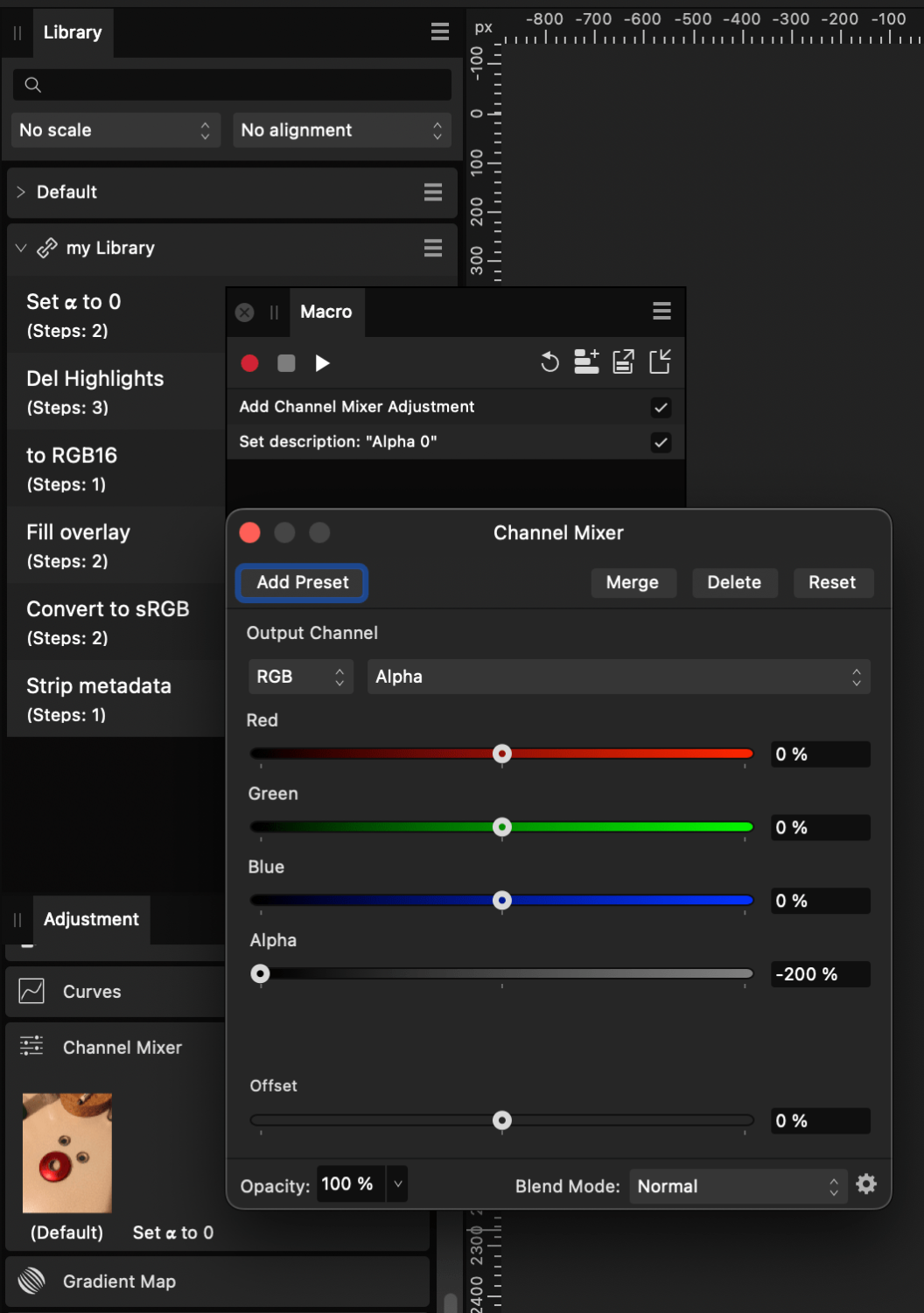-
Posts
38 -
Joined
-
Last visited
Everything posted by Haffinity
-
After installing the last update of AP, I noticed that AP sometimes crashes while it is inactive for a while: AP was hidden or the AP window was minimized (I use Stage Manager) then. macOS 13.6 I attach the last genenerated crash report. I have a few more Affinity Photo 2 Affinity Store-2023-09-25-172356.ips
-
Thank you, @lepr I see. Now I also think, I understand better the difference between a Live Filter Layer and an Adjustment Layer, something that always puzzled me. A filter usually needs to inspect the neigborhood (more or less wider) of each pixel whereas an adjustment layer adjusts the pixels independently of their neigbors. Therefore it makes sense to apply Live Filter Layers as Mask Layer or as released standalone layer. Clipping hinders the filter algorithm, one could even assume that in this case its result is undefined, maybe you are lucky and the effect is usable.
-
I have a question about the difference between using a Live Filter layer as a clipped mask layer and a clipped child layer. When I add a Live Filter to an active Pixel Layer, it is created as a Mask Layer. But I can also create it as a clipped child layer with the mouse. The difference in the result surprises me. Can anyone explain the difference? I have built an example with Box Blur to show the different results. Live Filter.afphoto
-
Surely you mean that export's function preview is almost unusable. By the way: The workaround using ⌥ mouse scrolling works for jpeg export but not for pdf-export, very strange. @Lee D: In my opinion, the preview should be offered as an option like before V2.1 , and then as a separate window view with suitable controls for zooming. I do not need the preview at every export.
-
Thank you so far! So I'm waiting for the next release. Let me know if you need more tests on my side.
-
Hi Dan, a service provider, not myself, has scanned the slides (several hundred), some of which are over 40 years old. The results are mostly unsatisfactory (garbage in - garbage out). I was asked by the disappointed client to save the stuff to some extent and she gave me an USB stick with the scan results. There was no preprocessing outside AP. I just used the application FastRawViewer (LibRaw LLC) to select the images where enhancement might be worthwhile and sent the images in groups of 5 to 10 to AP where they were opened in tabs. Then for each tab in AP: I edited the image, I cropped it, I exported it as downscaled jpeg (reducing its file size to ~10%), closed the tab Archive.zip
-
I don't know what key combination would excite me. Simple hacks will not make us happy. On a Mac, the only one that would really come into question for layer renaming would be the Enter key. My vision: there is a hotkey that enables/disables a keyboard focus on the Layers panel. As a user of vim, ESC seems to make sense to me. Now I can walk through the hierarchy of layers with the cursor keys like in Finder's list view, collapsing and expanding with ← and →, select a layer for renaming with Enter. On this basis Serif can then implement further conveniences (toggle Lock/Unlock, Hide/Show) for keyboard lovers.
-
Hi @Dan C, unticking Hardware Acceleration and switching to OpenGL did not help. This time AP crashed at the forth edit, again during cropping with straigthening. Just Before cropping I adjusted highlights and shadows and desaturated the red tones with HSL adjustment. Affinity Photo 2-2022-12-06-100220.ips MEDIAFIX_IMG48881-Recoveryfile.afphoto
-
Hi @Dan C, the delay is fine, I can imagine what is going on at support when you release new versions of your products. These crashes happen when I edit multiple images in succession as described above. The adjustments I make before or after cropping are probably pretty common (live denoise, live clarity, live shadows/highlights, HSL, curves, brightness) As I wrote before: The crashes occur after I have already processed several similar images in mostly very similar ways. After the abort, I can restart AP and continue editing the last image as desired until it "pops" again a few images down the line (always when cropping with straightening). After writing this bug topic, I changed my workflow: I no longer straighten the images with the Crop Tool, but use the Live Perspective or switch into Develop Persona to apply some rotation in Lens Correction. Finally, I crop the image in the Photo Persona without straighten it. Unfortunately, macOS has deleted the original crash reports in the meantime and they are apparently not included in Time Machine backups. That's why I tried to reproduce the aborts again. Today it took me 10 image edits to provoke a crash when cropping. For reference I append the original image and the recovery file, which was presented after restart of AP. Affinity Photo 2-2022-12-02-174759.ips MEDIAFIX_IMG48890 recovery file.afphoto
-
Sorry wrong forum, please move to Affinity Photo forum.
-
AP 2.0.0, macOS Ventura 13.0.1, Intel iMac AP Settings: Retina Rendering: Automatic (Best) Hardware Acceleration: Enable Metal compute acceleration, AMD Radeon Pro 555 (Metal) When trying to enhance multiple scans from diapositives, AP crashed several times when cropping the image (JPEG): Cropping with Custom Ratio Straightening the image by ⌘-dragging the mouse Dragging handles to set crop size to eliminate transparent edges: AP crashes When I restart AP, cropping the same image as before works without crashing AP. After processing more of such images (without restarting AP each time) AP breaks again at the 5th to 10th image while cropping. I reported the crashes to Apple and also got several crash reports in Console. Grüße Hans-Peter
-
No issues with AP 2 found yet, you have obviously done a good job But there is one thing that bothers me: When I export an image (usually JPEG or PDF), a preview is now always generated in the dialog . This sometimes takes several seconds to complete. Usually I don't need this, I would like to have the possibility to switch off this preview like in AP 1.
-

Blend Ranges: Adjusting Source Layer Range
Haffinity replied to Haffinity's topic in V1 Bugs found on macOS
Hi Callum, I have found that I need to restart AP to reproduce the effect. I am testing with an 8MP jpeg. When I turn off the metal acceleration, the effect does not occur. When I turn metal acceleration back on, the effect is there again. The spinning beach ball seems to only ever appear the first time after restarting AP with acceleration enabled. After that I can use the blend options in other layers or files without any delay. Do you recommend turning off acceleration permanently or is that a bug in AP? regards Hans-Peter ---- iMac (Retina 4K, 21.5-inch, 2017) 3 GHz Quad-Core Intel Core i5 8 GB 2400 MHz DDR4 AMD Radeon Pro 555 -
When I start adjusting the Source Layer Range by adding the first new node, I get a spinning beach ball for more than 10 seconds. After that I can use the dialog as expected (moving the node, adding new nodes). Macos 12.3 AP 1.10.5
-
Hi @NathanC, First of all, thank you for your support. A problem that is difficult to reproduce is always unpleasant. I suspect a connection with the long uptime of the program. Since the start of AP takes an annoying long time, I rarely quit AP, so it is active for several days. A few days ago I selected two pdf-files in the Finder and then opened them together with AP from Finder's context menue. AP got stuck on the second file. After the forced restart of AP everything worked again as usual. I could imagine a long running complex gui application like AP sometimes reveals a hidden bug in Monterey (or vice versa of course).
-
Hi @NathanC, Here is what I had done: I repeatedly cut some tickets from the TIFF: For each ticket: I selected it with the rectangular marquee tool I copied it ⌘C or ⌘X New from clipboard Back to tab with TIFF Now I had several tabs open in AP: One with the TIFF and for each ticket one separate tab with a pixel layer. Than I applied some fine selections, cropping and adjustments to the tickets. Finally I started to export the tabs to jpeg. For each tab this resulted to "Metadata could not be embedded". --- Just before to submit this reply, I have tried to repeat the steps just described. This time I was able to export the extracted tickets without any error message. I am puzzled now! karten-1.tif
-
AP 1.10.5, macOS 12.3 working on some scanned TIFF files in AP. Eventually I try to export to jpeg and get error message "Metadata could not be embedded". Saving as AP-file works. In order to export I have to uncheck "Embed metadata" in more... Same issue when exporting as png or psd. Another (maybe related) symptom: AP does not calculate Estimated File Size any more and show only "Calculating..." and "Generating preview..." (without consuming CPU). Attach sample file. 1987-12-08 The Kinks.afphoto
-
@David in Яuislip: Thank you very much for your hint and even more for attaching the adapted xml file. Now the lens is automaticly recognized as expected. After reading your reply, I also rediscovered the tutorial video. I had watched it months ago, but I couldn't "translate" it for my problem then. Only now I understand the procedure. I admit that it is difficult to present the existing diverse documentation on AP in a way that can be easily found and understood by people like me.
- 8 replies
-
- raw
- lens correction
-
(and 3 more)
Tagged with:







